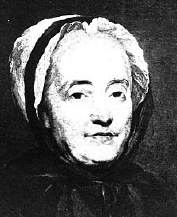Madame de Graffigny
| Françoise d'Issembourg d'Happoncourt, Madame de Graffigny | |
|---|---|

Madame de Graffigny
|
|
| Born |
11 February 1695 Nancy, Duchy of Lorraine |
| Died | 12 December 1758 (aged 63) Paris, France |
| Title | Madame de Graffigny |
Françoise de Graffigny, née d'Issembourg Du Buisson d'Happoncourt (11 February 1695 - 12 December 1758), was a French novelist, playwright and salon hostess.
Initially famous as the author of Lettres d'une Péruvienne, a novel published in 1747, she became the world's best-known living woman writer after the success of her sentimental comedy, Cénie, in 1750. Her reputation as a dramatist suffered when her second play at the Comédie-Française, La Fille d'Aristide, was a flop in 1758, and even her novel fell out of favor after 1830. From then until the last third of the twentieth century, she was almost forgotten, but thanks to new scholarship and the interest in women writers generated by the feminist movement, Françoise de Graffigny is now regarded as one of the major French writers of the eighteenth century.
Françoise d’Issembourg d’Happoncourt was born in Nancy, in the duchy of Lorraine. Her father, François d’Happoncourt, was a cavalry officer. Her mother, Marguerite Callot, was a great-niece of the famous Lorraine artist Jacques Callot. While she was still a girl, her family moved to Saint-Nicolas-de-Port, where her father was commander of the duke of Lorraine's horse guards.
On 19 January 1712, not yet seventeen years old, Mademoiselle d'Happoncourt was married in the church of Saint-Nicolas-de-Port to François Huguet, a young officer in the duke's service. He was a son of the wealthy mayor of Neufchâteau, Jean Huguet. Like her father, he was an écuyer or squire, the lowest rank of nobility. In honor of the marriage, the groom received from his father the estate at Graffigny and the couple took the title "de Graffigny" as their name. On her side, the bride received a large house inherited by her mother from Jacques Callot, situated in Villers-lès-Nancy, where the couple lived for about six years.
François de Graffigny seemed to have a promising future, and the couple produced three children within five years: Charlotte-Antoinette (born June 1713, died December 1716); Jean-Jacques (born March 1715, lived few days) and Marie-Thérèse (born March 1716, died December 1717). But he was a gambler, drunk and wife-beater, who was jailed for domestic violence. In 1718, deeply in debt and already living apart, the Graffignys signed a document, which gave her authority to deal with the family's finances and required him to leave Lorraine for Paris. In 1723 she obtained a legal separation. He died in 1725, under mysterious circumstances. As a widow, Françoise de Graffigny was free from her brutal husband, but she never fully recovered from the financial losses or the emotional trauma of her marriage.
...
Wikipedia
